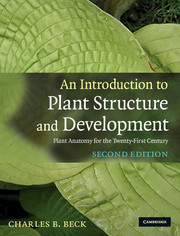Book contents
- Frontmatter
- Contents
- Preface to the second edition
- Preface
- Acknowledgements
- General references
- Chapter 1 Problems of adaptation to a terrestrial environment
- Chapter 2 An overview of plant structure and development
- Chapter 3 The protoplast of the eukaryotic cell
- Chapter 4 Structure and development of the cell wall
- Chapter 5 Meristems of the shoot and their role in plant growth and development
- Chapter 6 Morphology and development of the primary vascular system of the stem
- Chapter 7 Sympodial systems and patterns of nodal anatomy
- Chapter 8 The epidermis
- Chapter 9 The origin of secondary tissue systems and the effect of their formation on the primary body in seed plants
- Chapter 10 The vascular cambium: structure and function
- Chapter 11 Secondary xylem
- Chapter 12 The phloem
- Chapter 13 Periderm, rhytidome, and the nature of bark
- Chapter 14 Unusual features of structure and development in stems and roots
- Chapter 15 Secretion in plants
- Chapter 16 The root
- Chapter 17 The leaf
- Chapter 18 Reproduction and the origin of the sporophyte
- Glossary
- Index
Preface to the second edition
Published online by Cambridge University Press: 05 June 2012
- Frontmatter
- Contents
- Preface to the second edition
- Preface
- Acknowledgements
- General references
- Chapter 1 Problems of adaptation to a terrestrial environment
- Chapter 2 An overview of plant structure and development
- Chapter 3 The protoplast of the eukaryotic cell
- Chapter 4 Structure and development of the cell wall
- Chapter 5 Meristems of the shoot and their role in plant growth and development
- Chapter 6 Morphology and development of the primary vascular system of the stem
- Chapter 7 Sympodial systems and patterns of nodal anatomy
- Chapter 8 The epidermis
- Chapter 9 The origin of secondary tissue systems and the effect of their formation on the primary body in seed plants
- Chapter 10 The vascular cambium: structure and function
- Chapter 11 Secondary xylem
- Chapter 12 The phloem
- Chapter 13 Periderm, rhytidome, and the nature of bark
- Chapter 14 Unusual features of structure and development in stems and roots
- Chapter 15 Secretion in plants
- Chapter 16 The root
- Chapter 17 The leaf
- Chapter 18 Reproduction and the origin of the sporophyte
- Glossary
- Index
Summary
Although it has been only five years since this book was first published, research activity during this period in many areas of plant development has resulted in much new and important information. The basic information on plant structure is quite stable. As a result, inclusion of new information about various aspects of development comprise the major changes in this 2nd edition. In addition, a new section on the evolution of tracheary elements has been added.
The areas expanded and/or upgraded include the structure and function of the cytoskeleton, and its roles in cell wall formation and pollen tube tip growth; the role of auxin and other hormones in development, especially in the development of tracheary elements, as well as in cambial activity and tissue patterning, and the role of PIN proteins in the movement of auxin from cell to cell by auxin efflux transporters. The discussion on the mechanism of movement of stomatal guard cells has been expanded and improved. Sections on long-distance transport in the secondary xylem and phloem have been modified to emphasize widely accepted mechanisms of transport, and the discussion of bidirectional transport in the phloem has been expanded. The discussion of gravitropism has been brought up to date. Finally, throughout the book, discussions of the role of genetics in plant development have been expanded.
I believe the changes listed above have made the book more useful to advanced students and researchers without adversely affecting its usefulness as an introductory plant anatomy textbook.
- Type
- Chapter
- Information
- An Introduction to Plant Structure and DevelopmentPlant Anatomy for the Twenty-First Century, pp. xiii - xivPublisher: Cambridge University PressPrint publication year: 2010

